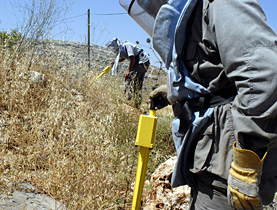
Cluster bombs threaten Lebanese future

More than 100 countries including Switzerland last week agreed to sign a treaty banning cluster bombs, but it will take years before the effects are felt.
In southern Lebanon, where the Israelis dropped hundreds of thousands of these dangerous devices in its 2006 war against the Hezbollah movement, the Swiss Foundation for Mine Action is attempting to tackle the problem.
“If you make the slightest mistake handling one of these, you’ll have a really bad day,” says Scott, standing in a minefield near Harouf in southern Lebanon.
After 20 years as a demolition specialist in the New Zealand army, followed by ten more years defusing mines in Iraq, Kosovo, Tajikistan and Afghanistan, he knows exactly what he is talking about.
Today, he works for the Swiss Foundation for Mine Action (SFMA) in Lebanon, where he has been active since the end of the 2006 war.
This conflict saw the Israelis make heavy use of their cluster bombs in the last three days before the ceasefire, dropping around one million of them in the south of the country, according to the United Nations.
Israel apparently managed to clear out its stocks, since many of those found on the ground date back to the Vietnam War period.
Around 40 million square metres of land were affected by this bombardment. With up to 30 per cent of cluster failing to go off on impact – versus one to three per cent for conventional munitions – it means that swathes of land are effectively mined.
Challenges
Demining the zone is problematic, especially since the Israelis have refused to supply maps of the zones that were targeted.
The UN’s coordination centre for demining has been forced to find out first-hand from the local population where the threat lies. The SFMA and six other contractors use the results for their own work.
Scott and his team arrived in Harouf a few weeks ago. Since then, they have managed to clear 30,000 square metres and neutralise 15 American-made M77 cluster bombs, some of them just outside the village school.
“Each time we find a bomb, we extend the surface we have to explore 50 metres in every direction,” explains Scott.
This morning, the team is scanning an area after discovering a mine the previous day. The heat is made worse by the heavy protection and the helmets worn by the demining crew.
Not far away, two locals trained by Scott are searching through a rocky patch covered with weeds and small bushes.
“It’s the worst kind of terrain along with urban zones,” Scott tells swissinfo. “The bombs that don’t explode can end up in the most unlikely places.”
Youssef cuts away some yellow grass with a pair of clippers, before moving his detection stick very slowly a few centimetres above the ground.
Frequent breaks
For Scott, his biggest enemies are habit and over-confidence, both of which can have instantaneous and damaging results.
“Last September one of my crew made the mistake of moving his foot forward at the same time he was cutting the grass,” he explains. “He was lucky to be alive afterwards with only cuts to his legs and arms.”
To avoid fatigue and potentially deadly mistakes, demining teams take frequent breaks from their work.
“If working conditions and the weather are good, we work for 45 minutes then take a 15-minute break,” says Scott. “But if there is a lot of stress or it’s very hot, we can work for just 20 minutes and take ten-minute breaks.”
The SFMA team also includes five medics, who are always available to help with first aid and evacuate anybody injured to the nearest hospital. Since the end of the war, 13 demining specialists have been killed in southern Lebanon.
Today, there are no accidents in Harouf and the priority zone near people’s homes is almost totally cleared. But the secondary zones, like the hills overlooking the village, “will probably always remain dangerous”, warns Scott.
swissinfo, Pierre Vaudan in Harouf
Cluster munitions are large weapons deployed from the air or launched from the ground that release dozens or hundreds of smaller submunitions.
Those deployed by aircraft are most often called bomblets, while those launched from the ground are usually referred to as grenades.
Their wide-area effect nearly always causes civilian casualties when they are used in populated areas.
Many of the submunitions do not explode on impact as designed, causing civilian casualties for months or years to come.
According to Cluster Munition Coalition at least 14 countries have used cluster munitions: Britain, Eritrea, Ethiopia, France, Israel, Morocco, the Netherlands, Nigeria, Russia, Saudi Arabia, Sudan, Tajikistan, the United States and the former Yugoslavia.
It adds that the weapon caused more civilian casualties in Iraq in 2003 and Kosovo in 1999 than any other weapon system.
Also known as the Oslo process, the Cluster Munitions Process was launched in February 2007 when a group of 46 states agreed to the Oslo Declaration.
This committed them to “conclude by 2008 a legally binding international instrument that prohibits the use and stockpiling of cluster munitions that cause unacceptable harm to civilians and secures adequate provision of care and rehabilitation to survivors and clearance of contaminated areas”.
Before the final negotiations in Dublin there were conferences in Oslo (February 2007), Lima (May 2007), Vienna (December 2007) and Wellington (February 2008).

In compliance with the JTI standards
More: SWI swissinfo.ch certified by the Journalism Trust Initiative

























You can find an overview of ongoing debates with our journalists here . Please join us!
If you want to start a conversation about a topic raised in this article or want to report factual errors, email us at english@swissinfo.ch.